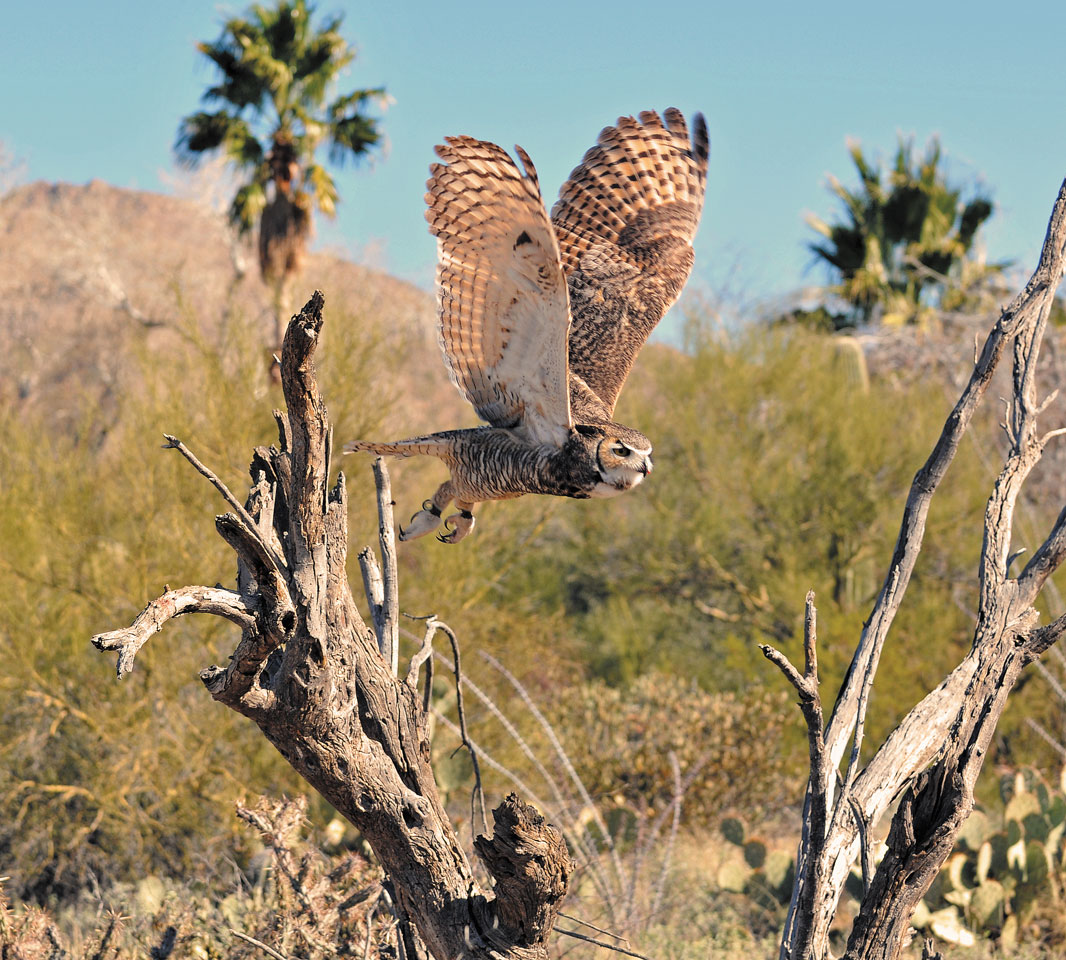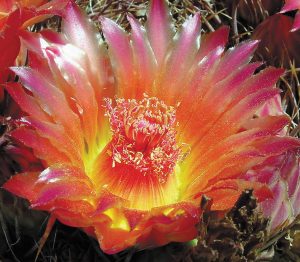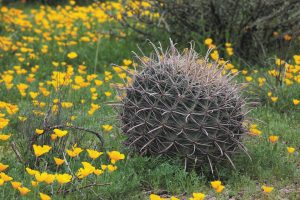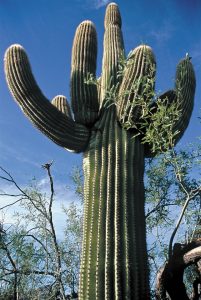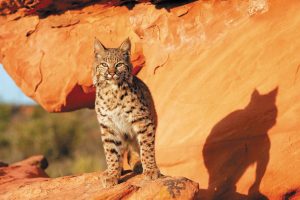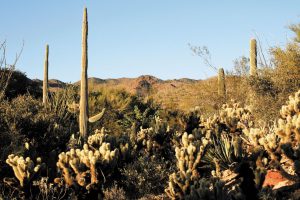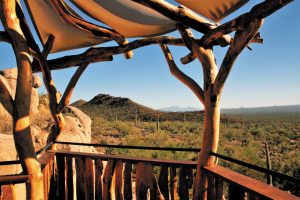Don’t miss this award-winning attraction just west of Tucson.
By Diane Morey Sitton
January 2020
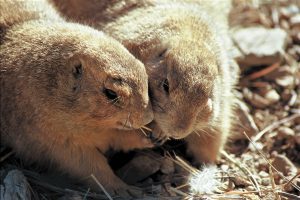
The Arizona-Sonora Museum outside Tucson is home to prairie dogs and many other forms of desert life.
Stroll among towering saguaro cacti, hear and feel hummingbirds as they hover inches away, and observe the movements of mountain lions and bighorn sheep. Do that, and you will have experienced only a tiny part of the attractions at the Arizona-Sonora Desert Museum, which also has an aquarium, an art gallery, a simulated cave — in all, it’s a 98-acre showcase.
The museum is the Tucson area’s number-one attraction as voted by TripAdvisor.com users, and it has been rated among the top museums in the entire United States.
Most visitors allow a few hours to explore the grounds, but if you have more time, you’ll find it amply filled. The expanse includes a 2-mile network of wide, accessible paths that connect 16 botanical gardens featuring various desert habitats. In addition, ongoing docent demonstrations are located throughout the grounds. See live animal presentations at the Warden Oasis Theater; and a half-hour birds-of-prey show called Raptor Free Flight is not to be missed. Some shows are provided only in the cooler months of October through April.
Since 85 percent of the museum experience is outdoors, bring a hat, comfortable shoes, and sunscreen, and don’t forget a reusable water bottle (filling spigots are available).
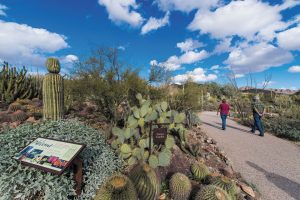
In the Cactus Garden, more than 100 species can be found, including some that are rare and threatened.
Upon arrival, check the digital schedule of the day’s featured events. Your adventure can begin with a docent-led Desert Discovery Tour (daily; times vary depending on the season); or, use the museum map and head out on your own expedition. Either way, the first place most people go is the Earth Sciences Center cave, since it’s a short stroll from the visitors center.
Inside the man-made limestone cavern, exhibits illustrate cave flora and fauna, as well as the slow process of stalagmite and stalactite formation. Nearby, a kid-luring side tunnel — 75 feet of sinuous, low-clearance space — provides a realistic caving experience for anyone willing to explore. Luminous ruby, amethyst, and emerald crystals beckon from an adjacent hall. They are part of the museum’s comprehensive regional mineral collection.
Outside, the trail leads to a mountain woodland environment. White-tailed deer, Mexican gray wolves (an endangered species), and black bears reside here. Don’t miss the flock of thick-billed parrots (another endangered species) that hang out next to the mountain lion habitat.
The half-mile-long Desert Loop Trail is a rugged downhill-uphill hiking experience. Along the way, naturalistic enclosures with invisible fencing separate javelinas and coyotes from human hikers. Often, at dusk, the coyotes sing as they prepare for the night. The songsters also make noise to keep track of family members; or, just for the fun of it.
Saguaro (pronounced “sah-wah-ro”) cactus, one of the defining plants of the Sonoran Desert, is prevalent along this trail. Typically, the slow-growing columnar giants require up to 75 years to develop their iconic arm-like branches. Recognized as the largest cactus in the United States, saguaros commonly grow to 40 feet tall and live for 200 years.
By the way, visitors can access the Raptor Free Flight show area from this trail.
On the way back to the main trail, don’t miss Cat Canyon, home to bobcats, ocelots, grey foxes, and porcupines.
At the main trail junction, hundreds of agave plants await inspection at the Agave Garden, the newest of the Desert Museum’s major theme gardens. Here, docents explain which varieties are used for making rope, brush bristles, and other useful products. Tequila, they point out, is made from blue agave. Birds, bats, and bees pollinate agaves, which bloom but once in their lifetime.
Just ahead, shade and a gurgling stream offer respite at the Riparian Corridor, home to river otters, beavers, and bighorn sheep. Often, visitors linger at the Cottonwood Café for ice cream and other refreshments.
Nearby, some 20 native bird species share a walk-in aviary, including the Gambel’s quail; the gila woodpecker; and that cartoon of the Sonoran Desert, the greater roadrunner. The roadrunner, a swift member of the cuckoo family, rarely flies, but it has been clocked at up to 20 miles per hour.
Back outside, folks veer right on the path to visit the Ironwood Terraces Restaurant; the Ironwood Art Gallery; and the Warden Oasis Theater, home to live bird and animal programs. Walk left and you’ll come to the Hummingbird Aviary, where aerial acrobats steal the show as they dart, hover, and even fly backward. The desert naturally has several hummingbird species, such as black-chinned, Anna’s, and calliope. Look closely and you can spot the birds’ tiny nests.
At the Warden Aquarium, exhibits illustrate the importance of water in maintaining the Sonoran Desert’s status as the “lushest desert on Earth.” The freshwater gallery highlights the region’s rivers and aquatic life. Look for the pikeminnow, a 6-foot-long, 100-pound carnivore, among other memorable marine residents. As for saltwater critters, check the frogfish, balloonfish, moray eels, and other species. Kids enjoy watching the seahorses propel themselves from plant to plant.
Although the Arizona-Sonora Desert Museum is touted as a showcase for some of the toughest animals and plants on earth, the miracle of the museum is that it also celebrates some of the most fragile. Here, falcons share the vast desert sky with butterflies; fishhook barrel cacti hobnob with paper-thin poppies; and lizards cool themselves in shadows cast by coyotes.
The Arizona-Sonora Desert Museum is an amazing place of contrasts, surprises, and rugged beauty. Discover it all for yourself.
Details
Arizona-Sonora Desert Museum
2021 N. Kinney Road
Tucson, AZ 85743
(520) 883-2702
www.desertmuseum.org
Open daily, year-round
Hours: 7:30 a.m. – 5:00 p.m. March through September
8:30 a.m. – 5:00 p.m. October through February
Parking is free and includes ample space in an RV area. However, be sure to avoid Gates Pass Road if you are driving any kind of RV. From Tucson, take Interstate 19 to the Ajo exit westbound. Follow Ajo Way to Kinney Road (about 8 miles) and turn right. Follow Kinney Road for 7.5 miles. The museum is on the left.
A majority of the exhibits are accessible by wheelchair. If you have a trained service animal as defined by the Americans with Disabilities Act (ADA), please check with Guest Services. No pets (emotional support animals, etc.) permitted.

